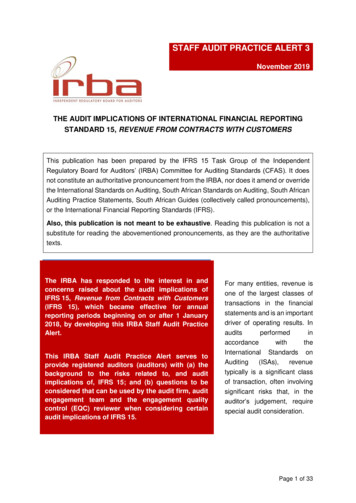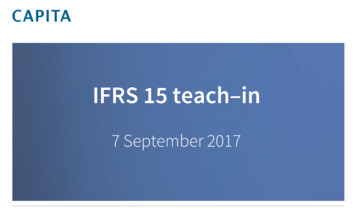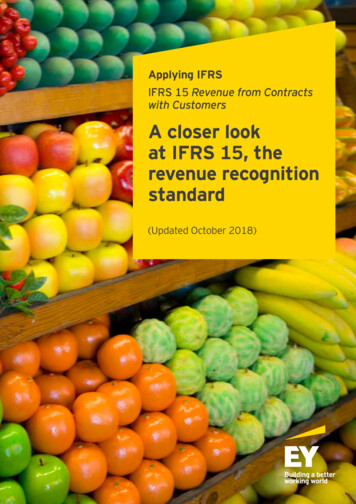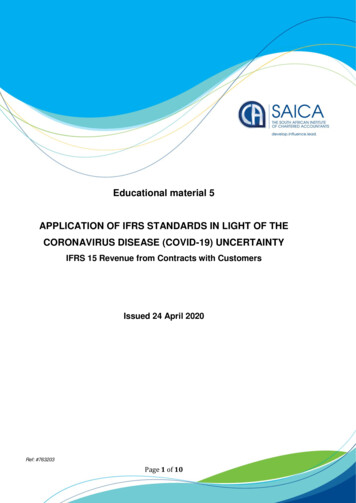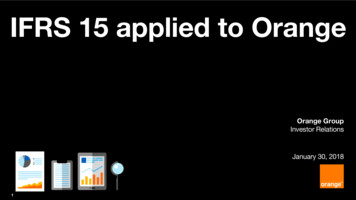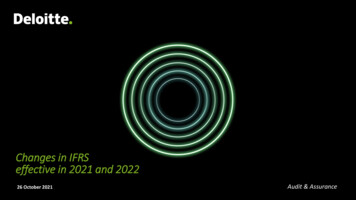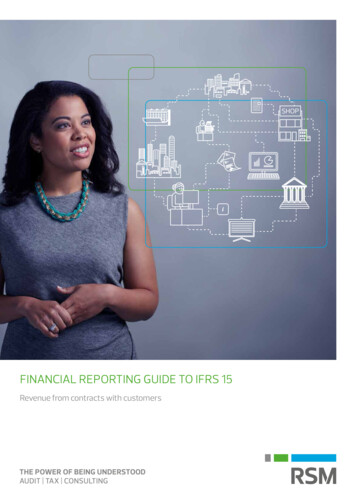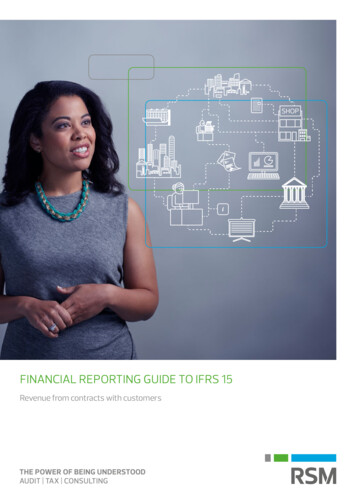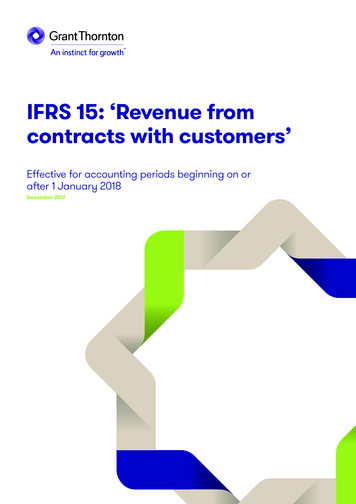
Transcription
IFRS 15: ‘Revenue fromcontracts with customers’Effective for accounting periods beginning on orafter 1 January 2018December 2017
IFRS 15: ‘Revenue fromcontracts with customers’The IASB published the new IFRS 15 Revenue from contractswith customer’s standard, in order to create a single model forrevenue recognition for contracts. IFRS 15 will promote greaterconsistency and comparability across industries and capitalmarkets. The actual impact on each company’s top line willdepend on their specific customer contracts and how they haveapplied existing accounting standards. effective for accounting periods beginning on or after1 January 2018; provide a single accounting model for Revenue fromcontracts with customers; greater consistency and comparability across industriesand capital markets.Scope IFRS 15IFRS 15 applies to all entities that enter into contracts withcustomers to provide goods, services or intellectual property,except the following: lease contracts within the scope of IAS 17;insurance contracts within the scope of IFRS 4;financing arrangements within the scope of IAS 39;financial instruments within the scope of IFRS 9;guarantees other than product warranties;non-monetary exchange between entities in the same line ofbusiness to facilitate sales to third-party customers; contracts that are not with customers (e.g. risk-sharingcontracts).1. IFRS 15 Appendix A2 IFRS 15: ‘Revenue from contracts with customers’Definition of a customerIFRS 15 defines a customer “as a party that has contractedwith an entity to obtain goods or services that are an output ofthe entity’s ordinary activities in exchange for consideration1.”In transactions involving multiple parties, it could be lessclear which counterparties are customers of the entity. Forsome arrangements, multiple parties could all be consideredcustomers of the entity. Depending on the specific facts andcircumstances, the customer can be identified.In certain transactions, a counterparty may not always bea ‘customer’ of the entity but a collaborator or partner thatshares in the risks and benefits of developing a productto be marketed. This is common in the pharmaceutical,bio-technology, oil and gas, and health care industries.However, depending on the facts and circumstances, thesearrangements may also contain a vendor-customer relationshipcomponent. Such contracts could still be within the scopeof IFRS 15, at least partially, if the collaborator or partnermeets the definition of a customer for some, or all, aspectsof the arrangement. Entities will need to use judgement todetermine whether transactions are between partners actingin their capacity as collaborators or reflect a vendor-customerrelationship.
Exhibit AUnder IFRS 15 it can be difficult to identify thecustomer in transactions involving multiple parties.Entities will need to use judgement to identify thecustomer and to determine whether transactionsare between partners acting in their capacityas collaborator or reflect a vendor-customerrelationship.The five step modelThe IASB provided a five step model in order to recogniserevenue form contracts with customers.Identify the contract(s) with a customer1Identify the performance obligations2Determine the transaction price3Changes from current IAS 18standardUnder the current IAS 18 standard, revenue transactionsoften must be separated into components that are accountedfor under different revenue standards. For example atransaction involving the sale of goods and a customer loyaltyprogramme. Under the new IFRS 15 standard, this separation ofcomponents will not be required.Allocate the transaction price to theperformance obligations4IAS 18 currently specified the accounting treatment for therecognition and measurement of interest and dividends. Interestand dividend income are excluded form the scope of IFRS 15.Recognise revenue when or as an entityExhibit BThe new IFRS 15 standard does not contain aseparation of the revenue transactions intocomponents. IFRS 15 provides a one singleaccounting model, separation is not needed sincethe treatment under IFRS 15 is the same.Interest and dividends are excluded from the scopeof IFRS 15.satisfies performance obligations5Step 1: Identify the contract(s) with a customerIFRS 15 defines a contract as “an agreement between two ormore parties that creates enforceable rights and obligations. Acontract can be written, oral or implied by an entity’s customerbusiness practices. For purposes of IFRS 15, a contract doesnot exist if each party has an enforceable right to terminate awholly unperformed contract without compensating the otherparty.IFRS 15 model applies only when: a contract that fits the definition of a contract within thescope of IFRS 15 can be identified; the contract has commercial substance; the parties have approved the contract; the entity can identify;–– each party’s rights,–– the payment terms for the good and services to betransferred. it is probable the entity will collect the consideration.If a customer contract does not meet these criteria, revenue isrecognised only when either: the entity’s performance is complete and substantially allIFRS 15: ‘Revenue from contracts with customers’ 3
of the consideration in the arrangement has been collectedand is non-refundable; the contract has been terminated and the considerationreceived is non-refundable.Entities can also combine two or more contracts and accountfor them as a single contract if they are entered into at or nearthe same time. There are serval criteria in order to combinecontracts.Were contractsnegotiated as a packagewith a single commercialobjective?yesyesnoAre contractsfor a singleperformance obligation?yesnoTreat as separatecontracts4 IFRS 15: ‘Revenue from contracts with customers’ the scope of the contract extends due to the addition ofpromised goods or services that are distinct; and the price of the contract increases with a compensationwhich, in order to express the circumstances of thatparticular contract, expresses the selling price of the entity’sadditional promised goods or services and any appropriateadjustments of that price.If a contract review is not processed as a separate contract,the legal entity must process the promised goods or servicesthat have not yet been transferred (i.e., the remaining goodsor services) at the date of the contract review, using one of thefollowing applicable methods:noDoes consideration in onecontract depend on theprice or performance ofanother contract?Contract renewal can occur if the parties to a contract approveto revision that creates or changes existing new enforceablerights and obligations. A contract can be written, oral or impliedby an entity’s customer business practices. The legal entitymust process a contract as a separate contract if both of thefollowing conditions are present:Treat as single contract The legal entity must process the contract as a terminationof the existing contract and the creation of a new contract ifthe remaining goods or services are distinguished from thegoods or services transferred on or before the date of thecontract review. The legal entity must process the contract as part of theexisting contract if the remaining goods and services are notindistinguishable and therefore part of a single performanceobligation partially completed on the date of the contractreview.
Step 2: Identify the performance obligationsAfter identifying the contract, the entity has to identify theperformance obligations within that identified contract. Aperformance obligation is an agreement settled in a contract totransfer (1) a good or service, or a bundle of goods or servicesthat is ‘distinct’ or (2) a series of distinct goods or services thatare substantially the same and meet certain criteria.A promised good or service is ‘distinct’ if both of the followingcriteria are met: the customer can benefit from the good or service either onits own or with other resources readily available to them. Areadily available resource is a good or service that is soldseparately (by the entity or by another entity) or that thecustomer has already obtained; it is separately identifiable from other promises in thecontract (i.e. the good or service is distinct within the contextof the contract).Indicators that an entity’s promises to transfer goods orservices are not separately identifiable include: significant integration services are provided (i.e. the entity isusing the goods or services merely as inputs to produce thespecific output called for in the contract); the goods or services significantly modify or customise otherpromised goods or services in the contract (or are modifiedby them); the goods or services are highly dependent on, orinterrelated with, other promised goods or services in thecontract.DistinctCustomer can benefiteither alone or withother readily availableresourceReadily available resource Sold separately orcustomer has alreadyobtained the resourcefrom a third party. Separately identifiableSignificant integrationservices notprovidedNo significantcustomisationonorNot highlydependent orinterrelatedIFRS 15: ‘Revenue from contracts with customers’ 5
Step 3: Determine the transaction priceIFRS 15 defines the transaction price as the amount ofconsideration an entity expects to be entitled to in exchangefor the goods or services promised under a contract excludingany amounts collected on behalf of third parties (for examplesales taxes). Entities should consider the following effects whendetermining the transaction price:1.2.3.4.5.variable consideration;the constraint on variable consideration;time value of money;non-cash consideration;consideration payable to the customer.1. Variable considerationIf a contract includes a variable consideration, the transactionprice has to be estimated. There are two methods in order toestimate the transaction price:1. the expected value or2. the most likely amount of consideration to be received.Entities will need to use judgement to identify the best methodto estimate the transaction price. The entity should use thesame method to estimate the transaction price throughout thelife of a contract. If the entity expects to refund a portion of theconsideration to the customer, a liability should be recognised forthe amount of consideration it reasonably expects to refund.Exhibit CAn exception to the general principles on variableconsideration applies to revenue from a salesbased or usage based royalty promised inexchange for a licence of intellectual propertywhere the licence is the only or predominant itemin the contract to which the royalty relates.2. Constraint on variable considerationIf the consideration in a customer contract includes an amountthat is variable, an entity is required to evaluate whether theamount of variable consideration included in the transactionprice need to be constrained. Entities have to do this in orderto ensure that an entity recognises revenue only to the extentit is highly probable there will not be a significant reversal ofrevenue when the related uncertainty resolves.3. Time value of moneyIFRS 15 entities are required to reflect the time value of moneyin it estimate of the transaction price if the contract includes asignificant financing component. In order to determine whethera financing component is significant, an entity must include: the difference between the promised consideration and thecash price; the combined effect of:6 IFRS 15: ‘Revenue from contracts with customers’–– the expected length of time between delivery of the goodsor services and receipt of payment;–– the prevailing interest rates in the relevant market.A contract may not have a significant financing component if: advance payments have been made but the transfer of thegood or service is at the customer’s discretion; the consideration is variable based on factors outside thevendor’s and customer’s control (e.g. a sales-based royalty); a difference between the promised consideration and thecash price relates to something other than financing such asprotecting one of the parties from non-performance by theother.4. Non-cash considerationIf a customer promises consideration in a form other than cash,an entity measures the non-cash consideration at fair valueto determine the transaction price. If an entity is unable toreasonably measure the fair value of non-cash consideration, itindirectly measures the consideration by referring to the standalone selling price of the goods or services promised under thecontract.5. Consideration payable to the customerConsideration payable to a customer includes the amount thatan entity pays or expects to pay to a customer in the form ofcash or non-cash items. An entity reduces the transaction priceby the amount it owes to the customer, unless the considerationowed is in exchange for distinct goods or services transferredfrom the customer to the entity.If the customer transfers distinct goods or services to an entityin exchange for payment, the entity accounts for the purchaseof these goods or services similarly to other purchases fromsuppliers. If the amount of consideration owed to the customerexceeds the fair value of those goods or services, the entityreduces the transaction price by the amount of the excess.If the entity cannot estimate the fair value of the goods orservices it receives from the customer, it reduces the transactionprice by the total consideration owed to the customer.Step 4: Allocate the transaction price to the performanceobligationsEntities have to allocate the contract’s transaction price to eachseparate performance obligation within that contract a relativestand-alone selling price basis at contract interception. IFRS15 defines a stand-alone selling price as “the price at whichan entity would sell a promised good or service separately toa customer.” The best evidence of the stand-alone selling priceis the observable selling price charged by the entity to similarcustomers and in similar circumstances, if available. If not,the stand-alone selling price is estimated using all reasonablyavailable information (including market conditions, entityspecific factors, and information about the customer or classof customer), maximising the use of observable inputs. IFRS 15suggests the following three methods to estimate the standalone selling price.
Adjusted market assessment approach Expected cost plus margin approach Residual approachAllocation discounts and variable considerationIf the sum of the stand-alone selling prices for the promisedgoods or services exceeds the contract’s total consideration,an entity treats the excess as a discount to be allocated tothe separate performance obligations on a relative standalone selling price basis. However, an entity would allocate adiscount to only some of the performance obligations only if ithas observable evidence of the obligations to which the entirediscount belongs. IFRS 15 requires that variable considerationis allocated entirely to a single performance obligation (or toa distinct good or service that forms part of a performanceobligation) if and only if both of the following conditions havebeen met: the terms of the variable payment relate specifically to theentity’s efforts towards, or outcome from, satisfying thatperformance obligation (or distinct good or service); the result of the allocation is consistent with the amount ofconsideration to which the entity expects to be entitled inexchange for the promised goods or services.has no alternative use to the entity, and the entity has theright to receive payment for work performed to date. Anentity evaluates whether a promised asset has an alternativeuse to it at contract inception by considering whether it canreadily redirect the partially completed asset to anothercustomer throughout the production process. In addition,the right to payment should be enforceable, and a vendorconsiders the contractual terms, as well as any legislation orlegal precedent that could override those terms, in assessingthe enforceability of that right.An entity recognises over time revenue associated with aperformance obligation that is satisfied over time by measuringits progress toward completion of that performance obligation.IFRS 15 discusses two classes of methods that are appropriatefor measuring an entity’s progress toward completion of aperformance obligation: output methods; input methods.Changes in transaction priceThe legal entity must assign all further changes in thetransaction price to the performance obligations in thecontract on the same basis as at the start of the contract.Amounts allocated to a fulfilled performance obligationshould be included in the period in which the transaction pricechanges as revenue or as a reduction in revenue. The legalentity must proportionally allocate a change in the transactionprice to all performance obligations, unless another allocationis more in line with the economic reality.Step 5: Recognise revenue when or as an entity satisfiesperformance obligationsUnder IFRS 15, an entity recognises revenue when or as ittransfers promised goods or services to a customer. A “transfer”occurs when the customer obtains control of the good orservice. A customer obtains control of an asset (good or service)when it can direct the use of and obtain substantially all theremaining benefits from it.Control can be transferred at a point in time or over time.Control is considered to be transferred over time if one of thefollowing conditions exists: the customer controls the asset as it is created or enhancedby the entity’s performance under the contract; the customer receives and consumes the benefits of theentity’s performance as the entity performs. A customerreceives a benefit from the entity’s performance as the entityperforms if another entity does not have to substantiallypreform the work completed to date if it stepped in tocomplete the remaining obligation(s) under the contract; the entity’s performance creates or enhances an asset thatIFRS 15: ‘Revenue from contracts with customers’ 7
WarrantiesIFRS 15 identifies two types of warranties: Warranties that provide a service to the customer in additionto assurance that the delivered product is as specified in thecontract (called ‘service-type warranties’) Warranties that promise the customer that the deliveredproduct is as specified in the contract (called ‘assurancetype warranties’)Service-type warrantiesIf the customer has the option to purchase the warrantyseparately or if the warranty provides a service to the customerbeyond fixing defects that existed at the time of sale, the entityis providing a service-type warranty. This type of warrantyrepresents a distinct service and is a separate performanceobligation. Therefore, using the estimated stand-alone sellingprice of the warranty, the entity allocates a portion of thetransaction price to the warranty. The entity then recognisesthe allocated revenue over the period the warranty service isprovided.Assurance-type warrantiesIf the customer has the right on a warranty when he/shebuys a service or good, the entity is providing an assurancetype warranty. By providing this type of warranty, the sellingentity has effectively provided a guarantee of quality. Underthe standard, these types of warranties are accounted for aswarranty obligations and the estimated cost of satisfying themis accrued in accordance with the requirements in IAS 37.Contract costsIFRS 15 specifies the accounting treatment for costs an entityincurs in obtaining and fulfilling a contract to provide goodsand services to customers for both contracts obtained andcontracts under negotiation.Costs to obtain a contractUnder IFRS 15, the incremental costs of obtaining a contractare reconsidered as an asset if the entity expects to recoverthem. IFRS 15 permits an entity to immediately expensecontract acquisition costs when the asset that would haveresulted from capitalising such costs would have beenamortised in one year or less. Entities are permitted to choosethis approach as an accounting policy election and, if they do,must apply it consistently to all short-term contract acquisitioncosts. For example, sales commissions that are directly relatedto sales achieved during a time period would likely representincremental costs that would require capitalisation. In contrast,some bonuses and other compensation that are based onother quantitative or qualitative metrics likely do not meet thecriteria for capitalisation because they are not directly relatedto obtaining a contract.8 IFRS 15: ‘Revenue from contracts with customers’Costs to fulfil a contractIFRS 15 divides contract fulfilment costs into two categories:1. Costs that give rise to an asset2. Costs that are expensed as incurredWhen determining the appropriate accounting treatment forsuch costs, IFRS 15 makes it clear that any other applicablestandards are considered first. IFRS 15 stated that costs canbe capitalised even if the related revenue contract with thecustomer is not finalised. However, rather than allowing coststo be related to any potential future contract, the standardrequires that the costs be associated with a specificallyidentifiable anticipated contract. Costs that relate to a contractinclude one of the following:a. direct labour;b. direct materials;c. allocations of costs that relate to the contract or to contractactivities;d. costs that are explicitly chargeable to the customer underthe contract; ande. other costs that are incurred only because an entity enteredinto the contractWhen determining whether costs meet the criteria forcapitalisation, an entity must consider its specific facts andcircumstances. An example of costs incurred that generate orenhance resources of the entity that will be used in satisfyingperformance obligations in the future may be the intangibledesign and engineering costs related to future performancethat provide (or continue to provide) benefit over the term ofthe contract. For costs to meet the ’expected to be recovered’criterion, they need to be either explicitly reimbursable underthe contract, or reflected through the pricing on the contractand recoverable through margin.Amortisation and impairment of capitalised costsAny asset recorded by an entity is subject to an assessment ofimpairment at the end of each reporting period. An impairmentexists if the carrying amount of any asset exceeds the amountof consideration the entity expects to receive in exchange forproviding the associated goods and services, less the remainingcosts that relate directly to providing those good and services.However, before recognising an impairment loss on capitalisedcosts incurred to obtain or fulfil a contract, the entity will needto consider impairment losses recognised in accordance withanother standard (e.g., IAS 36 Impairment of Assets). Afterapplying the impairment test to the capitalised costs, anentity includes the resulting carrying amount in the carryingamount of a cash-generating unit for purposes of applying therequirements in IAS 36.
Licences of intellectual propertyIFRS 15 provides application guidance specific tot herecognition of revenue for licences of intellectual property,which differs slightly from the requirements applied to all otherpromised goods and services.Determining whether a licence is distinctThe application guidance provided on licences of intellectualproperty are only applicable to licences that are distinct.If a contract includes a multiple-element arrangement withpromises for additional goods and services that may be explicitor implicit, the entity first determines whether the licenceof intellectual property is distinct. This includes assessingwhether the customer can benefit from the licence on its own ortogether with readily available resources. To determine whethera licence is distinct follow the guidance on page 4.Determining the nature of the entity’s promiseFor all licences of intellectual property that are determined tobe distinct, an entity must determine the nature of the promiseto the customer. The standard states that entities provide theircustomers with either: A right to access the entity’s intellectual property as it existsthroughout the licence period, including any changes tothat intellectual property (‘a right to access’)Or A right to use the entity’s intellectual property as it exists atthe point in time in which the licence is granted (‘a right touse’)IFRS 15: ‘Revenue from contracts with customers’ 9
Extract from IFRS 15To determine whether an entity’s promise to grant a licence provides a customer with either a right to access anentity’s intellectual property or a right to use an entity’s intellectual property, an entity shall consider whether acustomer can direct the use of, and obtain substantially all of the remaining benefits from, a licence at the pointin time at which the licence is granted. A customer cannot direct the use of, and obtain substantially all of theremaining benefits from, a licence at the point in time at which the licence is granted if the intellectual propertyto which the customer has rights changes throughout the licence period. The intellectual property will change(and thus affect the entity’s assessment of when the customer controls the licence) when the entity continuesto be involved with its intellectual property and the entity undertakes activities that significantly affect theintellectual property to which the customer has rights. In these cases, the licence provides the customer witha right to access the entity’s intellectual property. In contrast, a customer can direct the use of, and obtainsubstantially all of the remaining benefits from, the licence at the point in time at which the licence is granted ifthe intellectual property to which the customer has rights will not change (see paragraph B61). In those cases,any activities undertaken by the entity merely change its own asset (i.e. the underlying intellectual property),which may affect the entity’s ability to provide future licences; however, those activities would not affect thedetermination of what the licence provides or what the customer controls.The nature of an entity’s promise in granting a licence is a promise to provide a right to access the entity’sintellectual property if all of the following criteria are met: the contract requires, or the customer reasonably expects, that the entity will undertake activities thatsignificantly affect the intellectual property to which the customer has rights (see paragraph B59); the rights granted by the licence directly expose the customer to any positive or negative effects of theentity’s activities identified in paragraph ; and those activities do not result in the transfer of a good or a service to the customer as those activities occur.Factors that may indicate that a customer could reasonably expect that an entity will undertake activitiesthat significantly affect the intellectual property include the entity’s customary business practices, publishedpolicies or specific statements. Although not determinative, the existence of a shared economic interest (forexample, a sales-based royalty) between the entity and the customer related to the intellectual property towhich the customer has rights may also indicate that the customer could reasonably expect that the entity willundertake such activities.It is important to note that when an entity is makingthis assessment, it must exclude the effect of any otherperformance obligations in the arrangement.Transfer of control of licenced intellectual propertyBased on whether the nature of the entity’s promise is aright to access or a right to use the intellectual property,the arrangement consideration allocated to the licensedintellectual property would be recognised over the licenceperiod (for a right to access) or at the point in time thecustomer can first use the licensed intellectual property (for aright to use).10 IFRS 15: ‘Revenue from contracts with customers’PresentationWhen each party has performed a contract, the legal personmust present the contract as a contractual or contractualobligation, depending on the relationship between the legalperson’s performance and the customer’s payment. If acustomer pays compensation or the legal person is entitledto an unconditional remuneration (ie a claim), the legal entitymust present the contract as a contractual obligation before agood or a service to the customer, when the payment is doneor, when this happens, when the payment is due. If the legalentity performs by transferring goods or services to a customerbefore the customer pays compensation or before payment isdue, the legal entity must present the contract as a contractualasset, excluding all amounts presented as a claim.
NotesThe legal entity must explain the following information unlessthose amounts are presented in profit or loss: Performance Obligations:The legal entity must provide information about itsperformance obligations in customer contracts, includinga description of the time when the legal entity usuallyperforms its performance obligations (for example, whenshipped, on delivery, as services are provided or uponcompletion of service), including the Time when performanceobligations are fulfilled in a billing and retention agreement. Practical solutions:If the legal entity chooses to use the practical solutionregarding the existence of a significant financingcomponent or the marginal cost of obtaining a contract, thelegal entity must mention this.More information?If you want to know more about IFRS 15, pleasecontact your personal advisor, or else HannekeKnoop, Head Department Professional PracticeAuditIFRS 15: ‘Revenue from contracts with customers’ 11
Impact IFRS 15The impact of IFRS 15 depends on the specific facts and circumstances. The effects for serval industries can be estimated in orderto provide companies an indication of the effect
and dividend income are excluded form the scope of IFRS 15. The new IFRS 15 standard does not contain a separation of the revenue transactions into components. IFRS 15 provides a one single accounting model, separation is not needed since the treatment under IFRS 15 is the same. Interest and dividends ar

